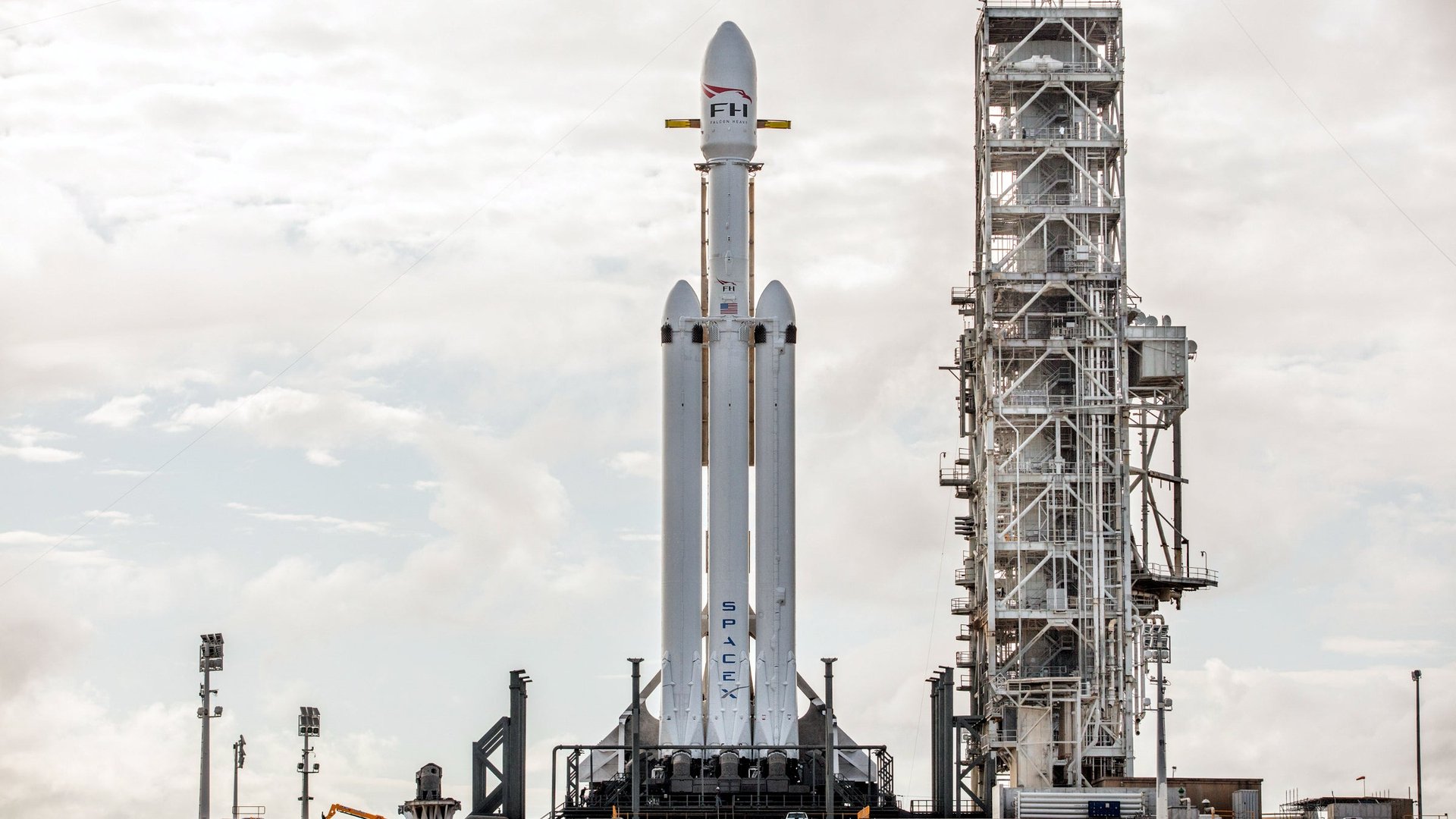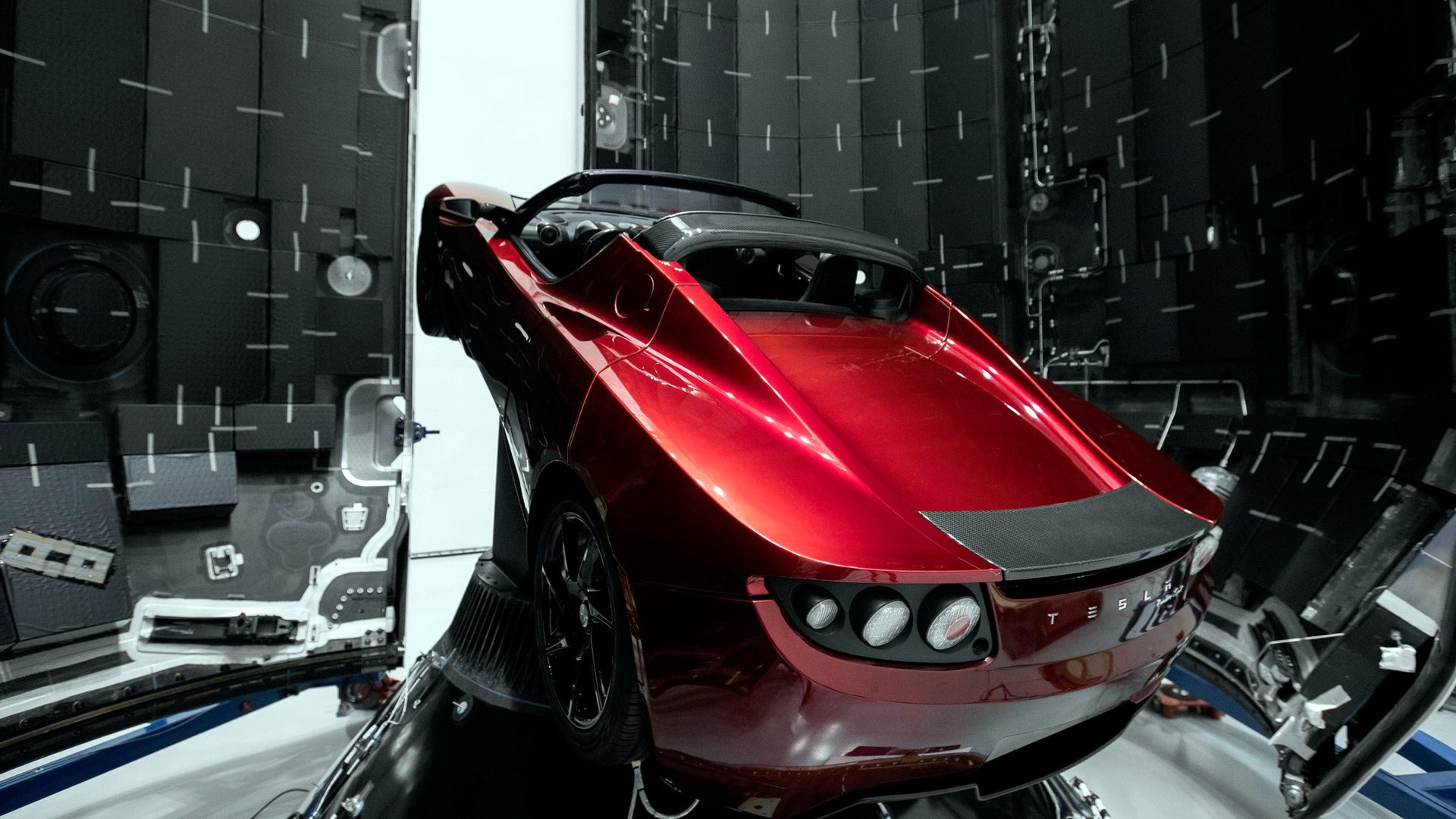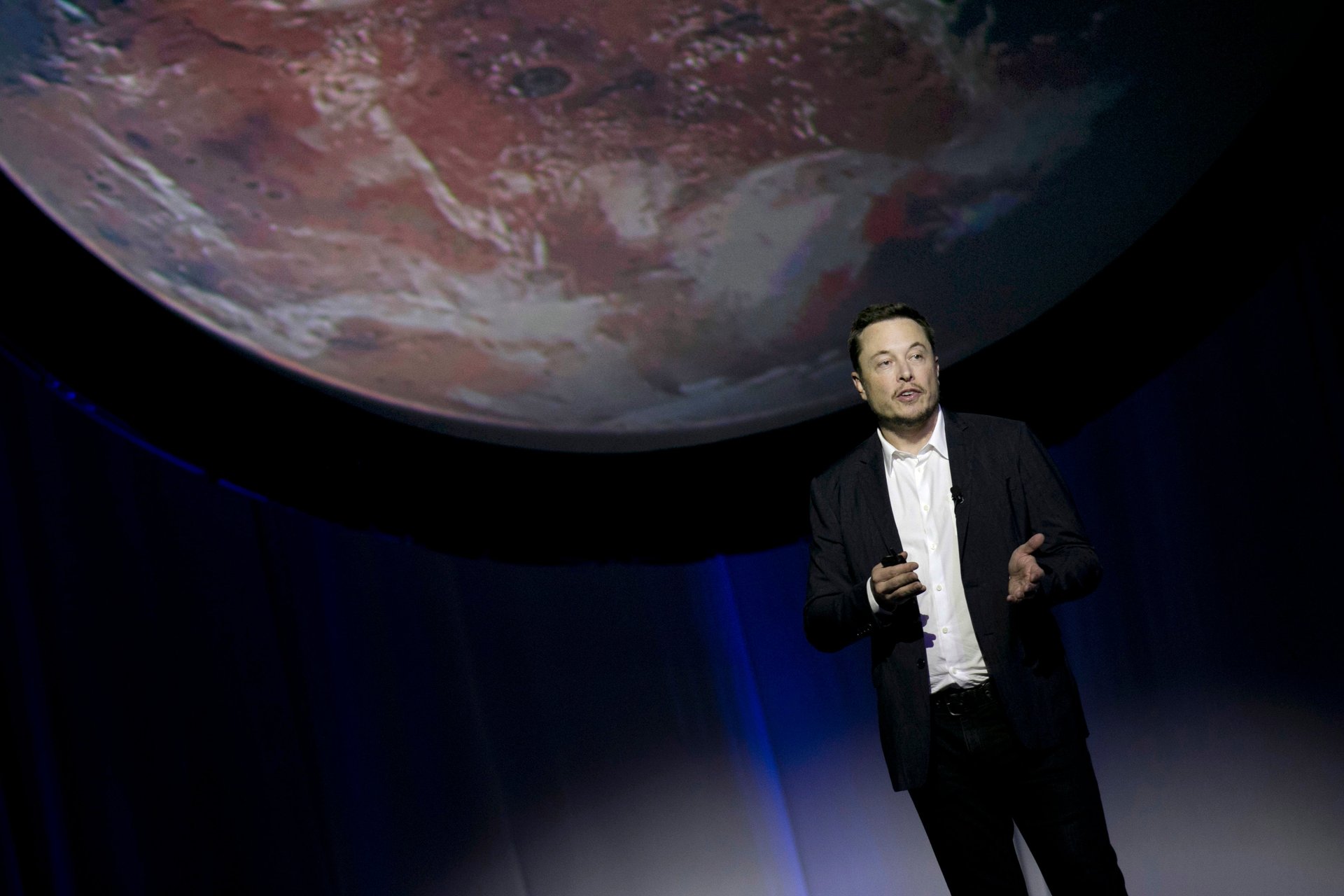Can Elon Musk disrupt deep space with the world’s most powerful rocket?
Elon Musk has sharp elbows when it comes to a new market.


Elon Musk has sharp elbows when it comes to a new market.
When SpaceX was competing to fly cargo to the International Space Station, Musk mocked his rival’s rockets. Vying to launch spy satellites, SpaceX sued the US Air Force for a chance to bid on classified launches. Plotting a satellite internet constellation, he promised a network “an order of magnitude” more sophisticated than his competitors. Tomorrow (Feb. 6), his space company will attempt to launch the largest rocket in the world, the Falcon Heavy—and if successful, the rocket entrepreneur could find himself set for collision with a gigantic rocket NASA been building for more than a decade.
SpaceX’s goal since 2002 has been to develop the technology to make humanity a multi-planetary species. The Falcon Heavy is the first vehicle built by Musk’s company with the capability of taking a usefully large scientific robot—or even, in stages, a human exploration mission—beyond earth orbit, and to another astronomical body.
“We can start to realistically contemplate missions like a Mars sample return—which requires quite a lot of lift capability because you’ve got to send a lander to Mars that still has enough propellant to return to Earth,” Musk said when he unveiled the concept for the vehicle in 2011. “It certainly opens up a wide range of possibilities, such as returning to the Moon and conceivably even going to Mars.”
The chronically over-promising executive figured that his company would be prepared to launch the vehicle the following year. Now, seven years later, that moment has finally arrived and much has changed in the private space sector: SpaceX is no longer an underdog, but a leading commercial launch company—at least in orbit where the company’s rockets launch satellites, service the ISS, and, in 2019, are expected to fly astronauts for the first time.
But is SpaceX ready to bring its brash attitude into deep space?
What is the Falcon Heavy?
The Falcon Heavy rocket is as tall as a 20-story building, consisting of three cylindrical rocket boosters strapped side-by-side, with a total of 27 engines. Firing together, these engines burn liquid oxygen and highly-refined kerosene to provide more than 2,500 tons of force, lifting the vehicle and its cargo off the ground and into space.
The rocket is, in appearance and design, akin to three of SpaceX’s Falcon 9 rocket boosters strapped together. This was indeed the basic inspiration for the rocket, but the concept turned to be harder than the company’s engineers had initially anticipated.
“This thing is a lot more complicated—as Elon admitted recently, it’s not just screwing two more vehicles onto the Falcon 9 and going from there,” veteran aerospace engineer James French told Quartz.
“The loads change, aerodynamics totally change, you’ve tripled the vibration and the acoustics,” Musk said at a NASA conference in 2017. “The amount of load you are putting through that center core is crazy…we had to redesign the whole center core airframe, it’s not like the Falcon 9 because it couldn’t take so much load. Separation systems ended up being, really, way more difficult than we thought. We were pretty naive about that.”
The company abandoned complicated techniques, like cycling fuel between the three core boosters during flight for increased efficiency. But the rocket is still a big innovation for one key reason: It will attempt to recover those three booster cores by flying two back to landing pads at Cape Canaveral and the third onto an autonomous ship. While the company has recovered numerous single-booster rockets using this technique, flying back three at once will an impressive accomplishment.
That’s assuming, of course, the rocket makes it far enough into the mission to worry about recovery.
What can the Falcon Heavy do?

“Put really big things in orbit, or take smaller things to a very high energy stage which makes them able to reach the outer planets,” French says. SpaceX estimates that it will be able to carry more than 63 metric tons to low-earth orbit a few hundred miles above the planet, or more than 16 metric tons to Mars, though it is not clear if these numbers represent the initial vehicle’s capabilities or its aspirations.
Tomorrow, it will attempt to carry one of Elon Musk’s Tesla roadsters into orbit around Mars, a joke cargo that’s more creative than the typical test-flight placeholder of a large tank of water or a concrete weight.
Why now?
The Falcon Heavy will be the most capable US rocket built since the Saturn V, a truly huge rocket that carried US astronauts to the moon during the Apollo program and last flew in 1973. Which raises the question of why we haven’t needed a rocket that big for more than four decades.
As a young engineer, French helped design propulsion systems for the Apollo program. In his view, the Saturn rocket was abandoned largely out of “bureaucratic stupidity.”
“We had one of the best launch vehicles that’s ever been built, an impeccable reliability record, and we threw it all away, basically to keep a bunch of NASA people employed building the space shuttle,” French says. Whether protecting space industry jobs drove the decision to abandon Saturn, the US eschewed further exploration into the solar system in favor of cheaper activity in low-earth orbit, like building the International Space Station and the Hubble space telescope, or launching satellites, which can all be done with less powerful vehicles.
Yet since 2004, US policy has been, in one form or another, to send human explorers beyond low-earth orbit and out—to orbit or land on the moon, to visit an asteroid, or to venture to Mars. NASA has spent billions financing a heavy lift rocket that scientists need to send explorers into deep space along with the equipment needed to survive. The first of those programs, known as Constellation, was cancelled in 2011, but a large rocket called the Space Launch System (SLS) is still under construction by Boeing, to be paired with with a Lockheed Martin-built spacecraft called Orion. The program has cost billions more than expected and suffered from severe delays.
SLS, when it is built, is expected to be two-thirds more powerful the Falcon Heavy, providing more than 4,000 tons of thrust at lift-off. Yet it is not expected to make its first flight until 2020, and then a second flight several years later. The SLS will cost approximately $1 billion a flight, compared to the ambitious starting $90 million price tag that SpaceX is advertising for the Falcon Heavy. While SpaceX rocket may not be as powerful as NASA’s official deep space ride, it has the virtue of availability.
“It’s most important to show that a private company, admittedly one that’s dependent on the government, but still a private company, is able to put together something like that,” French told me. “The real significance is not what they did, but they way they did it. We’ve got to be able to do these cheaper, and not sacrifice reliability.”
Who will buy the Falcon Heavy?

By and large, the US government.
The burgeoning private space sector is built around the advantages drawn from increasing power of small spacecraft like cubesats. These can be launched from the current crop of orbital rockets, and a new crop of small rocket start-ups has sprung up to service them, with one company putting a stunt payload of its own into space on its debut launch.
A few commercial satellite operators have satellites that might warrant Falcon Heavy’s extra oomph, but those are few and far between. So far, SpaceX has announced three commercial missions for the big rocket. To make use of its capacity efficiently would require launching multiple large satellites at once, a business model that “seems unlikely to be commercially workable at scale,” according to Carissa Christensen, a space industry analyst at Bryce Space and Technology.
Executives at competing launch vehicle firms said that the Falcon Heavy would instead appeal to the intelligence community and the US military, whose largest satellites cannot be launched by SpaceX’s current rocket; and for unmanned space probes launched by NASA scientists. Its main competitor in that arena is United Launch Alliance’s Delta IV Heavy, a rocket that costs $350 million on average.
One industry source says that SpaceX’s $90 million list price for the Falcon Heavy was “hyperbole” when considering government contracts, noting that Falcon 9 rockets flown for national security missions are priced around $97 million, $35 million over their list price. Falcon Heavy prices are said to been quoted in the $115 to $175 million range. (That’s without accounting for the potential of the rocket’s reusability, which could drive down the cost further in the future.)
Still, the executive told me, “if SpaceX ends up selling Falcon Heavies at $200 million, the US government saves a boatload of money.”
Private space is going big
Will any of those savings be applied to the much more expensive task of sending humans to explore the solar system? Under the Trump administration, the US has re-oriented space policy towards lunar exploration, and it has outlined an interest in working through fixed-price contracts to buy space services, as it does with SpaceX’s ferry service to ISS, versus traditional guaranteed-profit contracts, like the one Boeing has to build SLS. But so far, that interest has been limited to NASA’s near-earth missions.
“Heavy-lift rockets are strategic national assets, like aircraft carriers,” Scott Pace, the executive director of the Trump administration’s National Space Council, said last year, pointing out that his boss is the main customer for such vehicles. “There are some people who have talked about buying heavy-lift as a service as opposed to owning and operating, in which case the government would, of course, have to continue to own the intellectual properties so it wasn’t hostage to any one contractor. One could imagine this but, in general, building a heavy-lift rocket is no more ‘commercial’ than building an aircraft carrier with private contractors would be.”
To elaborate on Pace’s analogy, tomorrow’s launch might be compared to the US Navy’s contract for a new, $13 billion aircraft carrier, except if a start-up has delivered an aircraft carrier that’s half the size—and one tenth the price—two years ahead of schedule. Would the Navy be wise to purchase a couple of the cheaper alternatives rather than wait on its new behemoth?
“Falcon Heavy is essentially the first time the nation has obtained a lift capability like this for no cost to the taxpayers,” Phil Larson, an assistant dean at the University of Colorado’s engineering school who has been a White House space policy adviser and SpaceX spokesperson, told Quartz.
The partnership between legendary NASA and startup SpaceX has been built on the idea that SpaceX can do the simplest of NASA’s missions—humping gear up to low-earth orbit—in order for the space agency to focus on the truly advanced science behind deep space exploration. But the development and launch of a new heavy lift vehicle puts that relationship into question, with some arguing that NASA should include the rocket in its plans to return to the moon. At NASA, there is a sense that SpaceX needs to focus enough on its competition with Boeing to fly astronauts for the space agency, which has faced delays of its own.
The next generation rocket industry’s ambitions are even larger than the rocket sitting on the launch pad today. In the 2020s, SpaceX says it will build its “Big Falcon Rocket,” a new design for visiting Mars and the Moon, that would be more powerful than SLS. Jeff Bezos’ space company Blue Origin is developing a reusable rocket called New Glenn, which would be almost as powerful as the Falcon Heavy, and has promised a larger vehicle, called New Armstrong, that seems destined for lunar exploration.
“I can’t say how politicians will still be able to advocate for things like the SLS when you have the BFR and the New Glenn,” Joel Sercel, a veteran aerospace engineer, told me last year of a new generation of private space vehicles. If their builders can deliver these enormous machines to space on time and reliably, they will have turned a strategic national asset into a lucrative capital investment.
But that’s a big “if” in a business where new rockets have a tendency to explode at the most inconvenient moment. That’s why Musk—and the rest of the space world—will be watching the debut flight of the Falcon Heavy on the edge of their seats. If you can launch the most powerful rocket in the world, the sky is definitely not the limit.